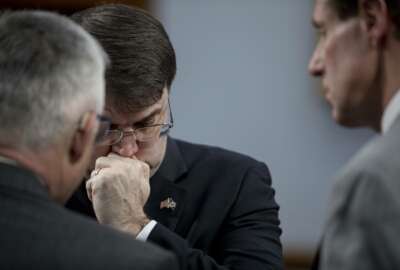
With coronavirus cases surging, VA’s ‘fourth mission’ now covers 46 states, Wilkie says
In wide-ranging discussion with reporters, Veterans Affairs Secretary Robert Wilkie downplayed the severity of a recent spike in coronavirus cases among veterans.
As new coronavirus hotspots have emerged across the country, the Department of Veterans Affairs has so far deployed nearly 1,000 of its own medical professionals to 46 states as part of its “fourth mission.”
The department is currently tracking some 5,254 active coronavirus cases, including 4,655 veterans and 432 VA employees, according to public data.
To date 40 employees have died due to complications from coronavirus. Since the beginning of the pandemic, VA has tracked 26,132 cumulative cases, including a total of 2,624 employee cases.
“We have not been hit particularly hard in the broader sense, in that we have about 600 beds occupied by veterans who have Covid,” VA Secretary Robert Wilkie told reporters Tuesday. “We’ve lost about 1,500, but the vast majority of veterans who contracted this have recovered. That has allowed us to increase our footprint across the country.”
The department is currently taking care of 9,000 non-veterans patients with the virus, he said.
VA employees, for example, are assisting some 30 nursing homes in Florida today with the state’s coronavirus response, Wilkie said. The department sent medical professionals on Sunday to help a state-run mental health hospital in Phoenix, Arizona.
“It’s balancing for us; our veterans come first,” Wilkie said. “[In] the New York metropolitan area, we did not have a great explosion in terms of veterans cases, at least veterans cases that required hospitalization, and that’s when we opened our doors. We look at conditions on the ground as to where to deploy.”
Wilkie downplayed the severity of the recent spike in coronavirus cases among the veteran population. Of the 9.5 million veterans in the VA health system, 4,500 have active cases today. More than 16,000 veterans have since recovered from the virus, which Wilkie described as an “under-covered news story.”
Read more Veterans Affairs news
Meanwhile, roughly 100 VA medical facilities have resumed at least one in-person service.
“We’re returning to normal, and we’re returning to normal in places where we can see on the ground that conditions warrant that,” Wilkie said. “There are still huge swaths of the country that have not been impacted by this, and our goal was to get them back into their normal routine as quickly as possible.”
Though some employees have expressed concern with the idea of resuming some in-person services during the pandemic, Wilkie said VA is equipped to “reopen” in places where it made sense. The department is stockpiling personal protective equipment in advance of future coronavirus surges, but it’s competing with every other health network for supplies.
He didn’t confirm whether the department had secured a 60-day to six-month supply of PPE that his top health official had suggested VA would need for a major rebound. VA is in a “good spot,” he said.
“The people on the frontlines were protected,” Wilkie said of VA’s PPE challenges. “I know there are anecdotes and stories out there about crises. We never ran out of equipment and we never had a crisis on the frontlines. Now was everybody given several changes of PPE who were not in contact with patients? No.”
Telehealth use at the VA is up 1000% during the pandemic and telework capacity has quadrupled.
“What I have seen is that people have been very happy, for the most part, with telework,” Wilkie said. “We have not seen any draw down in terms of productivity. In many cases, it’s gone up. That will be one of the things we look at when we return to normal operations.”
Read more Technology news
“For both employees and for our patients, telework and telehealth is the wave of the future as I see it,” he added. “I’ll have more data after this emergency ratchets down, but it’s very important. The rest of government should take a look at what we’re doing.”
For Wilkie, the pandemic has proved that VA has the ability to respond with agility and responsibility.
“We have shown that we can do many things at once,” he said.
Wilkie said VA would field the new electronic health record in the Pacific Northwest later this year, though he didn’t provide a specific timeline. The department in April announced its decision to pause the initial rollout of its multi-billion dollar electronic health record to its first site at the Mann-Grandstaff VA Medical Center in Spokane, Washington, due to the pandemic.
He also pointed to VA’s hiring surge as another example of the department adapting to emergency circumstances. The department has hired 23,000 new employees since mid-March.
“The old-Office of Personnel Management ways of doing business based on an industrial-age model do not suit us,” Wilkie said. “I could not be happier with the pace at which we have been hiring doctors and nurses and other health care workers.”
VA officials have previously praised OPM for its help and guidance in shortening the hiring and onboarding time during the pandemic.
The president last week signed new legislation into law that lifts an old pay cap previously placed on Title 38 senior executives at the Veterans Health Administration. Wilkie said the law should help VHA better attract and retain top medical professionals.
“We have to be realistic,” he said. “There are certain medical skills that we can’t attract unless we have the ability to compensate those professionals. We’re different. This is not the Department of Labor or the Department of Commerce. [There’s] no aspersions on them. We exist in a very different world.”
Copyright © 2025 Federal News Network. All rights reserved. This website is not intended for users located within the European Economic Area.
Nicole Ogrysko is a reporter for Federal News Network focusing on the federal workforce and federal pay and benefits.
Follow @nogryskoWFED
Related Stories

VA doesn’t have the personal protective equipment it needs to handle second pandemic wave





